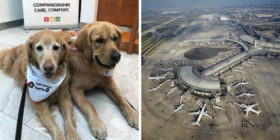TORONTO : There are numerous well-publicized examples of people reportedly discovering famous faces on everyday objects, from the visage of Jesus on a grilled cheese sandwich to the Virgin Mary on a flour tortilla and Elvis Presley on a potato chip.
Is it a miracle? Are these people just plain crazy?
Or is it something else?
Toronto researchers have found that “face pareidolia,” where onlookers report seeing well-known countenances in bread, clouds, smoke or rock formations, is normal and based on how the brain interprets and makes sense of visual stimuli.
“Most people think you have to be mentally abnormal to see these types of images, so individuals reporting this phenomenon are often ridiculed,” said lead researcher Kang Lee, a developmental neuroscientist at the University of Toronto.
“But our findings suggest that it’s common for people to see non-existent features because human brains are uniquely wired to recognize faces,” Lee said of the study published in the journal Cortex. “So that even when there’s only a slight suggestion of facial features, the brain automatically interprets it as a face.”
To conduct the study, researchers had 20 participants, aged 18 to 25, look at a series of “noise-making” images, so-called because they contain no discernible shapes.
However, participants were deliberately misled, Lee said Tuesday.
In one experiment, subjects were told that half the images contained faces. For a second test, they were told half the images contained a letter.
In about 35% of cases, those viewing the images reported seeing a face or a letter where none existed.
‘There are two possibilities. One is the people are just crazy’
“Then there are two possibilities,” said Lee. “One is the people are just crazy — they believe whatever we have told them — or they are actually seeing things.”
Turns out their brains, at least, do appear to be “seeing” something recognizable.
Using a technique called functional MRI to perform brain scans, researchers found that certain areas involved in either face or letter recognition “lit up” when participants discerned what they thought was a face.
That didn’t occur only in the visual cortex at the back of the brain, but also in a particular area of the frontal cortex that’s been implicated in face-processing.
Typically it was thought that when visual information is perceived by the retina, it is projected to the visual cortex at the back of the brain, then sent forward to the frontal lobe to be interpreted, he said..
“Now our evidence is suggesting that the information is actually going backwards, so the frontal brain sends it back to the visual cortex to heighten sensitivity to things we want to see, such as faces.”
Lee said one reason that people seem to identify a face or other object in a cloud or darkened room, for instance, is that the brain tries to make sense of visual inputs, sometimes filling in the blanks to create a recognizable shape.
‘If you are religious and you want to see Jesus, you’re going to see Jesus. If you want to see Mary, you’re going to see Mary’
It’s also a product of one’s expectations, such as the research subjects who were misled to believe that half the images they saw would contain a face or a letter.
“It depends on your personal experience and your personal expectations,” Lee said. “So for example, if you are religious and you want to see Jesus, then you’re going to see Jesus. If you want to see Mary, you’re going to see Mary.”
Another common example of pareidolia, defined as the imagined perception of a pattern or meaning where it does not exist, is seeing the man in the moon. Hearing hidden messages on recordings played in reverse is also a form of pareidolia.
The Rorschach inkblot test uses the phenomenon to try to gain insight into a person’s mental state.
Lee said figuring out what’s behind the propensity to perceive patterns from random visual data could help researchers better understand why some people with schizophrenia experience visual or auditory hallucinations, which can also occur with heavy substance abuse.
“They regularly see illusory things. And sometimes the imagery is extremely strong. Sometimes it can be very, very dangerous.”
Anxiety rooted in area of the brain previously thought to be a brake on stress, U.S. researchers say in landmark study
Do pictures steal 1,000 memories? Taking photos at events may damage the brain’s ability to recollect them: study
Lee said he also wanted to demystify the experience of pareidolia and point out that people who pick out iconic images on unlikely surfaces should not be laughed at or ridiculed.
“I think this a very general phenomenon that people do.”





Leave a reply